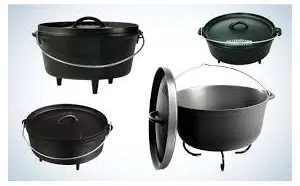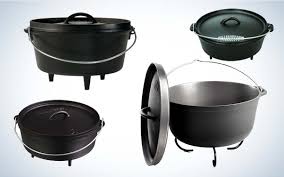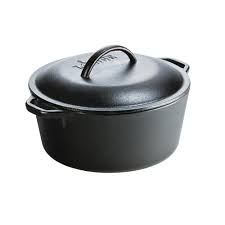The Timeless Elegance of the Dutch Oven: A Culinary Masterpiece
A Dutch oven is a versatile and durable cooking pot that comes in various materials, including cast iron, enameled cast iron, and others. It's known for its even heat distribution and excellent heat retention, making it ideal for a wide range of cooking techniques like braising, stewing, roasting, and baking. With proper care and maintenance, a Dutch oven can last for generations, becoming a cherished kitchen heirloom.
The Versatility of Dutch Ovens in Culinary Creations

In the world of culinary artistry, few tools stand as iconic and versatile as the Dutch oven. Its history spans centuries, tracing its roots back to 17th-century Holland, where it was first crafted with precision and care. Since then, the Dutch oven has become an indispensable kitchen companion, cherished by both professional chefs and home cooks alike. Its enduring popularity can be attributed to its remarkable ability to seamlessly transition from stovetop to oven, allowing for a wide range of cooking techniques and an unparalleled depth of flavor in dishes.
types of Dutch oven
- Traditional Cast Iron Dutch Oven:
- The classic and most well-known type of Dutch oven is made of seasoned cast iron. Known for its excellent heat retention and even cooking, it is a favorite among purists and outdoor enthusiasts. These ovens require regular seasoning to maintain their non-stick surface and prevent rusting.
- Enameled Cast Iron Dutch Oven:
- Enameled cast iron Dutch ovens have a porcelain enamel coating on the interior and exterior, which provides a non-stick surface and prevents the need for seasoning. They are easy to clean and come in a variety of colors, making them a popular choice for both cooking and serving.
- Aluminum Dutch Oven:
- Lightweight and highly conductive of heat, aluminum Dutch ovens are a popular choice for campers and hikers due to their portability. They are less expensive than cast iron options but may not offer the same level of heat retention.
- Stainless Steel Dutch Oven:
- Stainless steel Dutch ovens are known for their durability and resistance to staining or discoloration. They are often favored for cooking acidic or reactive foods, as they do not react with the ingredients.
- Ceramic Dutch Oven:
- Ceramic Dutch ovens are a newer entrant to the market, known for their attractive designs and vibrant colors. They provide even heating and are suitable for slow-cooking, roasting, and baking.
- Multi-Purpose Dutch Oven:
- Some Dutch ovens come with additional features, such as a reversible lid that can be used as a griddle or skillet. These versatile options add an extra layer of functionality to your cookware.
- Electric Dutch Oven:
- Electric Dutch ovens are standalone appliances that function similarly to traditional Dutch ovens. They have electric heating elements and offer precise temperature control, making them convenient for indoor cooking.
- Camp Dutch Oven:
- Designed specifically for outdoor cooking, camp Dutch ovens typically have three legs and a flat bottom to sit securely over coals or an open flame. They also feature a flanged lid, allowing coals to be placed on top for even heating.
- French Oven (Cocotte):
- Often used interchangeably with Dutch ovens, French ovens, or cocottes, are typically made of enameled cast iron. They are known for their elegant design and are favored for slow-cooking and braising in French cuisine.
- Mini Dutch Ovens:
- These smaller versions of traditional Dutch ovens are perfect for individual servings or for serving appetizers and desserts. They are also great for presentation at the dining table.
Uses of Dutch Oven:
- Braising:
- A Dutch oven is excellent for braising tough cuts of meat. The heavy lid traps moisture, allowing the meat to become tender and flavorful. It's a preferred method for dishes like pot roast, coq au vin, and beef bourguignon.
- Stewing and Soups:
- The Dutch oven's even heat distribution makes it perfect for simmering soups, stews, and chilis. The tight-fitting lid helps to lock in flavors and create rich, deeply flavored broths.
- Roasting:
- The Dutch oven's ability to evenly distribute heat makes it an excellent choice for roasting meats, poultry, and vegetables. It ensures that the food cooks uniformly and retains its moisture.
- Baking:
- Dutch ovens are a baker's best friend. The enclosed environment created by the Dutch oven's lid helps create a perfectly crisp crust on bread and pastries, while also ensuring a moist interior.
- Frying:
- The deep sides and sturdy construction of a Dutch oven make it ideal for frying. From classic fried chicken to crispy tempura vegetables, it provides a stable and controlled environment for frying.
- Baking Bread:
- The Dutch oven's ability to mimic the environment of a professional bread oven makes it perfect for baking artisanal bread. The sealed environment helps create a crispy crust and a tender crumb.
- One-Pot Meals:
- Dutch ovens are fantastic for creating one-pot wonders. You can combine various ingredients like meats, vegetables, and grains, and let them simmer together to create a flavorful and hearty dish.
- Baking Desserts:
- Dutch ovens can be used to bake a variety of desserts, from cobblers and crisps to bread pudding and even cakes. The even heat distribution ensures that the desserts cook uniformly.
- Deep Frying:
- The Dutch oven's deep sides make it a safe and efficient vessel for deep frying. Whether it's homemade donuts, French fries, or crispy fried fish, a Dutch oven can handle the job.
- Canning and Preserving:
- The large capacity of a Dutch oven makes it suitable for canning fruits, vegetables, and jams. It provides ample space for processing jars and maintaining a consistent temperature.
- Outdoor Cooking:
- Dutch ovens are a favorite among campers and outdoor enthusiasts. With their ability to withstand open flames and coals, they're perfect for cooking over a campfire.
- Simmering Sauces:
- The even heat distribution of a Dutch oven is ideal for simmering sauces, whether it's a rich marinara or a creamy Alfredo.
- Slow Cooking:
- Dutch ovens are well-suited for slow-cooking dishes that benefit from low and slow heat, such as braised short ribs, chili, or pulled pork.

Tips for Cooking with a Dutch Oven:
- Preheat Your Dutch Oven:
- Before you start cooking, it's essential to preheat your Dutch oven. This ensures even heat distribution and prevents food from sticking to the bottom.
- Season Your Cast Iron Dutch Oven:
- If you're using a traditional cast iron Dutch oven, it's crucial to season it regularly. This process involves applying a thin layer of oil and baking it to create a non-stick surface.
- Avoid Rapid Temperature Changes:
- Dutch ovens, especially those made of cast iron, can be sensitive to extreme temperature changes. Avoid transferring a hot Dutch oven directly from a hot stovetop to a cold surface or vice versa to prevent thermal shock, which can damage the cookware.
- Use the Right Utensils:
- When cooking with cast iron, opt for utensils made of wood, silicone, or nylon. Metal utensils can scratch the surface and potentially compromise the non-stick properties.
- Lid Orientation Matters:
- When using a Dutch oven for baking, ensure the lid's concave side is facing upward. This allows condensation to drip back into the dish, aiding in the cooking process.
- Adjust Cooking Time and Temperature:
- Cooking times and temperatures may need adjustment when using a Dutch oven. Its exceptional heat retention can result in faster and more even cooking compared to other cookware.
- Don't Overfill Your Dutch Oven:
- Avoid overfilling the Dutch oven, especially when braising or simmering. Leave some space to allow for expansion and prevent spillage.
- Monitor Liquid Levels:
- Keep an eye on the liquid levels, particularly during long, slow-cooking processes. Add more liquid if necessary to prevent the dish from drying out.
- Experiment with Different Cooking Techniques:
- Take advantage of the Dutch oven's versatility. Try various cooking techniques like braising, stewing, roasting, and baking to discover the full range of culinary possibilities it offers.
- Maintain and Clean Your Dutch Oven Properly:
- After use, clean your Dutch oven with hot water and a brush. Avoid using harsh detergents or abrasive scrubbers, as they can remove the seasoning. Dry it thoroughly to prevent rusting and apply a light coat of oil to maintain its non-stick surface.
- Use a Trivet or Heatproof Surface:
- When transferring a hot Dutch oven from the oven to the countertop or table, use a trivet or a heatproof surface to protect your countertops and prevent any potential damage.
- Store Your Dutch Oven Properly:
- To prevent moisture buildup and rusting, store your Dutch oven in a cool, dry place with the lid slightly ajar. Avoid stacking other heavy cookware on top of it.
How long do Dutch ovens last
With proper care and maintenance, a Dutch oven can last for generations, often becoming a cherished family heirloom. The longevity of a Dutch oven largely depends on the material it's made of and how well it's taken care of.
- Cast Iron Dutch Oven:
- A well-maintained cast iron Dutch oven can last indefinitely. With regular seasoning, proper cleaning, and storage in a dry environment, it can be passed down through generations.
- Enameled Cast Iron Dutch Oven:
- Enameled cast iron Dutch ovens are durable and can last a very long time. However, the enamel coating may chip or crack over time with heavy use. Proper care, such as avoiding extreme temperature changes and using non-metal utensils, can prolong its lifespan.
- Aluminum Dutch Oven:
- Aluminum Dutch ovens are generally less durable than cast iron options. They can last for many years with proper care, but they may be more prone to warping or damage if subjected to rough handling.
- Stainless Steel Dutch Oven:
- Stainless steel Dutch ovens are highly durable and resistant to staining or corrosion. With proper care, they can last a lifetime.
- Ceramic Dutch Oven:
- Ceramic Dutch ovens are generally less durable than cast iron or stainless steel options. While they can last for many years with proper care, they may be more susceptible to chipping or cracking.
- Multi-Purpose Dutch Oven:
- The lifespan of a multi-purpose Dutch oven depends on the materials used in its construction. Cast iron or enameled cast iron versions tend to be the most durable.
- Electric Dutch Oven:
- The lifespan of an electric Dutch oven can vary depending on the quality of the appliance and how well it's maintained. With proper care, it can last for many years.
- Camp Dutch Oven:
- A well-maintained camp Dutch oven, typically made of cast iron, can last for generations. Its durability and simplicity make it a long-lasting outdoor cooking tool.

proper care and maintenance
Proper care and maintenance are crucial for ensuring the longevity and performance of your Dutch oven. Whether it's made of cast iron, enameled cast iron, or another material.
- Seasoning (For Cast Iron Dutch Ovens):
- If you have a traditional cast iron Dutch oven, regular seasoning is essential. This process involves applying a thin layer of oil (such as vegetable oil or shortening) to the interior and exterior surfaces and then baking it in the oven. Seasoning creates a non-stick surface and helps prevent rusting.
- Avoiding Extreme Temperature Changes:
- Dutch ovens, especially those made of cast iron, can be sensitive to rapid temperature changes. Avoid subjecting them to extreme shifts in temperature, as this can lead to thermal shock and potentially damage the cookware.
- Use Appropriate Utensils:
- When cooking with a Dutch oven, use utensils made of wood, silicone, or nylon to avoid scratching the surface. Avoid using metal utensils, which can damage the seasoning (for cast iron) or enamel coating (for enameled cast iron).
- Cleaning with Care:
- After use, clean your Dutch oven with hot water and a brush or a non-abrasive sponge. Avoid using harsh detergents or abrasive scrubbers, as they can remove the seasoning (for cast iron) or damage the enamel coating (for enameled cast iron).
- Avoid Soaking in Water:
- Do not soak your Dutch oven for extended periods. Prolonged exposure to water can lead to rusting, especially for traditional cast iron models. Dry it thoroughly after washing.
- Dry Thoroughly:
- After washing, make sure to dry your Dutch oven completely, both inside and out. Place it on the stove or in the oven at a low temperature to ensure all moisture is evaporated.
- Store with Lid Slightly Ajar:
- To prevent moisture buildup and rusting, store your Dutch oven in a cool, dry place with the lid slightly ajar. Avoid stacking other heavy cookware on top of it.
- Re-season as Needed (For Cast Iron):
- Over time, the seasoning on a cast iron Dutch oven may wear off or become uneven. If this happens, simply re-season it by applying a thin layer of oil and baking it in the oven again.
- Inspect for Damage:
- Regularly inspect your Dutch oven for any signs of damage, such as chips in the enamel (if applicable) or rust spots. Addressing these issues promptly can help prevent further damage.
- Use and Rotate Regularly:
- Regular use helps maintain the seasoning on cast iron Dutch ovens. If you have multiple Dutch ovens, it's a good idea to rotate them to ensure they all receive regular use and seasoning.
the Dutch oven has transcended time and borders, leaving an indelible mark on the world of cooking. Its versatility, durability, and ability to create dishes of exceptional depth and flavor make it a cherished addition to any kitchen. Whether you're braising, baking, roasting, frying, or simmering, the Dutch oven is there to elevate your culinary creations to new heights.



